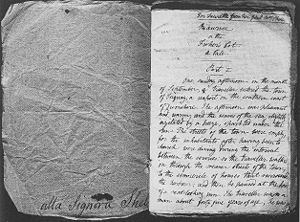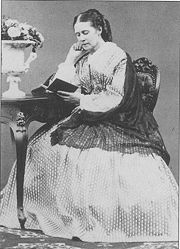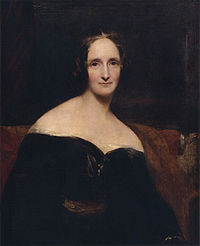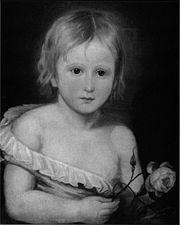
Maurice (Shelley)
Encyclopedia

Children's literature
Children's literature is for readers and listeners up to about age twelve; it is often defined in four different ways: books written by children, books written for children, books chosen by children, or books chosen for children. It is often illustrated. The term is used in senses which sometimes...
by the Romantic
Romanticism
Romanticism was an artistic, literary and intellectual movement that originated in the second half of the 18th century in Europe, and gained strength in reaction to the Industrial Revolution...
writer Mary Shelley
Mary Shelley
Mary Shelley was a British novelist, short story writer, dramatist, essayist, biographer, and travel writer, best known for her Gothic novel Frankenstein: or, The Modern Prometheus . She also edited and promoted the works of her husband, the Romantic poet and philosopher Percy Bysshe Shelley...
. Written in 1820 for Laurette Tighe, a daughter of friends of Percy
Percy Bysshe Shelley
Percy Bysshe Shelley was one of the major English Romantic poets and is critically regarded as among the finest lyric poets in the English language. Shelley was famous for his association with John Keats and Lord Byron...
and Mary Shelley, Mary Shelley tried to have it published by her father, William Godwin
William Godwin
William Godwin was an English journalist, political philosopher and novelist. He is considered one of the first exponents of utilitarianism, and the first modern proponent of anarchism...
, but he refused. The text was lost until 1997, when a manuscript copy was rediscovered in Italy, exciting both the scholarly community and the general public.
Maurice tells the story of a boy searching for a home and his encounters with a traveller who turns out to be his long-lost father. The story is narrated in a melancholy tone from several points of view and focuses on the theme of loss, particularly the separation of parents and children. Shelley explored this partly autobiographical theme in other works written at the time, including her novel Mathilda and her play Proserpine
Proserpine (play)
Proserpine is a verse drama written for children by the English Romantic writers Mary Shelley and Percy Bysshe Shelley. Mary wrote the blank verse drama and Percy contributed two lyric poems. Composed in 1820 while the Shelleys were living in Italy, it is often considered a partner to the...
. The story's straightforward language reflects that of the Romantic poet
Romantic poetry
Romanticism, a philosophical, literary, artistic and cultural era which began in the mid/late-1700s as a reaction against the prevailing Enlightenment ideals of the day , also influenced poetry...
William Wordsworth
William Wordsworth
William Wordsworth was a major English Romantic poet who, with Samuel Taylor Coleridge, helped to launch the Romantic Age in English literature with the 1798 joint publication Lyrical Ballads....
, whose works Shelley was reading while she composed Maurice.
Background

Mary Shelley
Mary Shelley was a British novelist, short story writer, dramatist, essayist, biographer, and travel writer, best known for her Gothic novel Frankenstein: or, The Modern Prometheus . She also edited and promoted the works of her husband, the Romantic poet and philosopher Percy Bysshe Shelley...
(Mary Godwin, at the time) ran off with Percy Bysshe Shelley
Percy Bysshe Shelley
Percy Bysshe Shelley was one of the major English Romantic poets and is critically regarded as among the finest lyric poets in the English language. Shelley was famous for his association with John Keats and Lord Byron...
to continental Europe, accompanied by Claire Clairmont
Claire Clairmont
Clara Mary Jane Clairmont , or Claire Clairmont as she was commonly known, was a stepsister of writer Mary Shelley and the mother of Lord Byron's daughter Allegra.-Early life:...
, Mary's stepsister. After six weeks of travelling, they returned to England but continued to live together. Mary returned pregnant with Percy's child, but their infant daughter died soon after her premature birth. Percy was alienated from his family and received little financial support from them; he was therefore harassed by creditors. In 1816, Mary and Percy had a second child, William. The same year, Claire Clairmont began an affair with the poet Lord Byron, and in January 1817 she had a daughter by him, Allegra. The group spent the summer of 1817 with Byron at Lake Geneva
Lake Geneva
Lake Geneva or Lake Léman is a lake in Switzerland and France. It is one of the largest lakes in Western Europe. 59.53 % of it comes under the jurisdiction of Switzerland , and 40.47 % under France...
, where Mary Shelley wrote Frankenstein
Frankenstein
Frankenstein; or, The Modern Prometheus is a novel about a failed experiment that produced a monster, written by Mary Shelley, with inserts of poems by Percy Bysshe Shelley. Shelley started writing the story when she was eighteen, and the novel was published when she was twenty-one. The first...
. That fall, Percy's wife, Harriet, committed suicide, and in December Percy and Mary were married. In September 1817, Mary and Percy had another child, Clara.
The group traveled to Italy in early 1818. They first surrendered Allegra to Byron in April, much to Claire's distress. In August, Percy Shelley took Claire to see Allegra, at her request. Percy arrived in Venice, telling Byron he had the entire family. Mary was thus summoned to Venice to substantiate Percy's story. However, baby Clara Shelley was sick and traveling made her even more ill. She died shortly after arriving in Venice. In the winter of 1818, Percy registered a child in Naples
Naples
Naples is a city in Southern Italy, situated on the country's west coast by the Gulf of Naples. Lying between two notable volcanic regions, Mount Vesuvius and the Phlegraean Fields, it is the capital of the region of Campania and of the province of Naples...
to himself and Mary: Elena Adelaide. However, it is unclear who this child's parents really were.
In 1819, the group moved to Rome
Rome
Rome is the capital of Italy and the country's largest and most populated city and comune, with over 2.7 million residents in . The city is located in the central-western portion of the Italian Peninsula, on the Tiber River within the Lazio region of Italy.Rome's history spans two and a half...
, where Mary and Percy Shelley's son William died. Mary Shelley had now lost all three of her children and was very depressed. Claire became increasingly concerned about Allegra, as Byron refused to allow her to see their daughter or reveal where she was. Mary, however, became pregnant again, with Percy Florence
Percy Florence Shelley
Sir Percy Florence Shelley, 3rd Baronet was the son and only surviving child of Percy Bysshe Shelley and his second wife, Mary Shelley. He was thus the only grandchild of Mary Wollstonecraft...
, and the group traveled from Rome to Pisa
Pisa
Pisa is a city in Tuscany, Central Italy, on the right bank of the mouth of the River Arno on the Tyrrhenian Sea. It is the capital city of the Province of Pisa...
and Florence
Florence
Florence is the capital city of the Italian region of Tuscany and of the province of Florence. It is the most populous city in Tuscany, with approximately 370,000 inhabitants, expanding to over 1.5 million in the metropolitan area....
. En route, they became friends with Lady Mountcashell, a former pupil of Mary Shelley's mother, Mary Wollstonecraft
Mary Wollstonecraft
Mary Wollstonecraft was an eighteenth-century British writer, philosopher, and advocate of women's rights. During her brief career, she wrote novels, treatises, a travel narrative, a history of the French Revolution, a conduct book, and a children's book...
, and George Tighe. Both were poets and, like the Shelleys, were republican
Republicanism
Republicanism is the ideology of governing a nation as a republic, where the head of state is appointed by means other than heredity, often elections. The exact meaning of republicanism varies depending on the cultural and historical context...
s and freethinkers. Lady Mountcashell referred to herself as "Mrs. Mason" after a character from Wollstonecraft's own children's story Original Stories from Real Life
Original Stories from Real Life
Original Stories from Real Life; with Conversations Calculated to Regulate the Affections, and Form the Mind to Truth and Goodness is the only complete work of children's literature by 18th-century British feminist Mary Wollstonecraft. Original Stories begins with a frame story, which sketches out...
(1788). The couple also had two children, Anna Laura Georgiana (called Laurette) and Nerina, who quickly became attached to Mary and Claire.
After traveling to Florence, Mary Shelley wrote to Lady Mountcashell, praising Laurette's "simplicity and frankness". By way of her mother, Laurette inquired after Mary's health and requested her presence. Mary Shelley invited Laurette to stay with her in Florence two months after the birth of Percy Florence, but the girl's mother could not bear to part with her. In early 1820, the group moved to Pisa and Claire became like an elder sister to Laurette, taking her to operas and the Carnival. In the summer, the group moved again, from Pisa to Livorno
Livorno
Livorno , traditionally Leghorn , is a port city on the Tyrrhenian Sea on the western edge of Tuscany, Italy. It is the capital of the Province of Livorno, having a population of approximately 160,000 residents in 2009.- History :...
, and Mary Shelley began researching her historical novel
Historical novel
According to Encyclopædia Britannica, a historical novel is-Development:An early example of historical prose fiction is Luó Guànzhōng's 14th century Romance of the Three Kingdoms, which covers one of the most important periods of Chinese history and left a lasting impact on Chinese culture.The...
Valperga
Valperga (novel)
Valperga: or, the Life and Adventures of Castruccio, Prince of Lucca is an 1823 historical novel by the Romantic novelist Mary Shelley, set amongst the wars of the Guelphs and Ghibellines,...
. Throughout the summer, Claire wrote anxiously to Byron, begging to see Allegra. Believing that the Shelleys were careless parents who were responsible for the deaths of their children and concerned that the children were not receiving proper religious training, he consistently refused to let Claire see their daughter.
Writing and publication

William Godwin
William Godwin was an English journalist, political philosopher and novelist. He is considered one of the first exponents of utilitarianism, and the first modern proponent of anarchism...
, publish Maurice as part of his Juvenile Library, but he refused. He may have thought it was too short or that it too closely resembled a story by Caroline Barnard entitled The Fisher-boy of Weymouth that he had just published in 1819. In his article on Maurice, L. Adam Mekler suggests that Godwin may also have rejected the story because of the "strong biographical parallels" with the history of the Shelleys and the Godwins.
The fate of the manuscript was unknown until it was rediscovered 177 years later by Cristina Dazzi in the summer of 1997. She found at in the home of the Dazzi family, Casa Cini, in San Marcello
San Marcello
San Marcello is a comune in the Province of Ancona in the Italian region Marche, located about 25 km west of Ancona.The municipality of San Marcello contains the frazione Acquasanta....
. She was looking through a box of old papers, searching for "something interesting" to add to an exhibit about the winter of 1827–28 when the poet Giacomo Leopardi
Giacomo Leopardi
Giacomo Taldegardo Francesco di Sales Saverio Pietro Leopardi was an Italian poet, essayist, philosopher, and philologist...
had visited and met Lady Mountcashell and her daughter. Excerpts were first published in an Italian book about Lady Mountcashell by Mario Curreli in 1997. One year later, Percy Shelley and Mary Wollstonecraft biographer Claire Tomalin
Claire Tomalin
Claire Tomalin is an English biographer and journalist. She was educated at Newnham College, Cambridge.She was literary editor of the New Statesman and of the Sunday Times, and has written several noted biographies...
published the entire story, along with a lengthy introduction and a typescript of the manuscript.
Plot summary
In "Part I", a traveller arrives in TorquayTorquay
Torquay is a town in the unitary authority area of Torbay and ceremonial county of Devon, England. It lies south of Exeter along the A380 on the north of Torbay, north-east of Plymouth and adjoins the neighbouring town of Paignton on the west of the bay. Torquay’s population of 63,998 during the...
, Devon
Devon
Devon is a large county in southwestern England. The county is sometimes referred to as Devonshire, although the term is rarely used inside the county itself as the county has never been officially "shired", it often indicates a traditional or historical context.The county shares borders with...
shire. He sees a funeral procession passing by and notices a beautiful, distressed young boy taking part. The traveller goes to a local inn, where a countryman tells the story of Maurice and the late-dead Old Barnet. Old Barnet was a fisherman married to Dame Barnet. She had died a little over a year ago and Old Barnet was distraught; he had no wife to come home to. One day, Maurice showed up and volunteered to help him out around the house while he was out fishing. Poor and sickly, Maurice could not perform difficult tasks, but he was diligent. Old Barnet grew to love Maurice, as did the villagers.
"Part II" opens with Old Barnet's brother informing Maurice that he must leave the cottage after one week. Maurice spends his days mourning the fisherman. One day the traveller returns to the village and seeks out Maurice; he stops at the cottage and asks to stay the night. He and Maurice talk and Maurice tells of his plans to leave the cottage and find work on a farm. He also tells the traveller of his poor family and how he does not want to be a bother to them, revealing that his father used to beat him because he did not believe Maurice was really ill. The traveller and Maurice sit together, enjoying nature, and discuss the pleasures of country life and reading. The traveller offers to care for Maurice and to educate him.
The traveller explains in "Part III" how he is the son of an Oxford mathematics professor. When young, he loved to read outdoors and wanted to know how the world worked. He became an architect and travelled throughout Europe. Eventually he married a lovely woman with whom he had a son, Henry. One day the couple left their son with his nurse during an outing and she fell asleep. When they returned, their son was gone, and he could not be found. The traveller spent years searching the countryside for his son; one day he met the woman, Dame Smithson, who had stolen his son. To please her sailor husband who wanted a child, she lied to him and said she was pregnant. Before his return, she needed a child, so she stole the traveller's. Unused to the harsh life of a peasant, the child suffered and became sickly. As a result, the woman's husband disliked him and beat him, believing him to be worthless. Hearing this story, Maurice reveals himself to be the traveller's son; he had changed his name to avoid the person he believed to be his cruel father. Overjoyed to be reunited with his son, the traveller buys the cottage for him and they return every once in a while. Maurice is educated, grows up, and travels widely. He returns to see that the cottage has disintegrated; he builds a new one for another poor fisherman's family, beside the lot of the old one.
Style, genre, and themes

Mary Shelley was reading the poetry of William Wordsworth
William Wordsworth
William Wordsworth was a major English Romantic poet who, with Samuel Taylor Coleridge, helped to launch the Romantic Age in English literature with the 1798 joint publication Lyrical Ballads....
while she wrote Maurice. Tomalin has argued that "Wordsworth does seem to preside over Maurice, with its clear, straightforward language, and its setting among simple people and poor labourers, and against elemental backgrounds of rocks and trees, cliffs and seashore".
Maurice's natural goodness never wavers in the story. Unlike Shelley's Frankenstein
Frankenstein
Frankenstein; or, The Modern Prometheus is a novel about a failed experiment that produced a monster, written by Mary Shelley, with inserts of poems by Percy Bysshe Shelley. Shelley started writing the story when she was eighteen, and the novel was published when she was twenty-one. The first...
, which suggests that environment determines a person's morality, Maurice assumes that people can be innately good. Maurice even forgives Dame Smithson, who stole him from his nurse. The story aims to generate sympathy in its readers. In contrast with other children's stories of its day, it lacks didacticism and draws no clear distinctions between virtue and vice.
Despite the appeal to sympathy, loss is the predominant theme of Maurice: parents lose their child; a mother yearns for a child to the point that she steals one; and "Maurice" loses his sense of identity. The overarching themes of the story are Romantic
Romanticism
Romanticism was an artistic, literary and intellectual movement that originated in the second half of the 18th century in Europe, and gained strength in reaction to the Industrial Revolution...
, according to Tomalin: "the vulnerability of childhood, and of parenthood; displacement, loss, pain, death and rehabilitation; delight in the natural world; and the power of time both to heal and to destroy".
The loss of children, in particular, may have had autobiographical and biographical resonances. Lady Mountcashell had separated from her husband and been forced to give up her children. A court had ruled Percy Bysshe Shelley
Percy Bysshe Shelley
Percy Bysshe Shelley was one of the major English Romantic poets and is critically regarded as among the finest lyric poets in the English language. Shelley was famous for his association with John Keats and Lord Byron...
unfit to raise the children from his marriage to his deceased first wife and placed them in the care of a court-appointed guardian. A third reference may be to Mary and Percy's own loss of three children. Literary critic A. A. Markley points out that Shelley wrote other works at this time that engaged with the issue of child-parent separation, most notably her novel Mathilda and the children's drama Proserpine
Proserpine (play)
Proserpine is a verse drama written for children by the English Romantic writers Mary Shelley and Percy Bysshe Shelley. Mary wrote the blank verse drama and Percy contributed two lyric poems. Composed in 1820 while the Shelleys were living in Italy, it is often considered a partner to the...
, both of which she worked on in 1820. Markley explains that Maurice is a reworking of Mathilda, "in which a long deferred reunion of father and child is orchestrated with happy rather than tragic results". This theme is also explored in Mary Shelley's short stories
Short story
A short story is a work of fiction that is usually written in prose, often in narrative format. This format tends to be more pointed than longer works of fiction, such as novellas and novels. Short story definitions based on length differ somewhat, even among professional writers, in part because...
"The Mourner", "The Evil Eye", and "The Pilgrims", as well as her novel Lodore
Lodore
Lodore, also published under the title The Beautiful Widow, is the penultimate novel by Romantic novelist Mary Shelley, completed in 1833 and published in 1835.-Plot and themes:...
(1835).
Mekler argues that the story may be a veiled criticism of Mary Shelley's stepmother, Mary Jane Clairmont. Dame Smithson lies to her husband regarding her children, a possible allusion to the unknown origins of Mary Jane Clairmont's own first two children and to her "propensity for falsehood". Mekler speculates that "in her theft of the first-born son, Dame Smithson replicates in metaphorical fashion Mary Jane's usurpation of the role as mother of the male heir that had originally belonged to Mary Wollstonecraft".
Reception
News of the discovery of Maurice excited both the scholarly community and the general public. Miranda Seymour writes in her biography of Mary Shelley that while the story itself was "no great work...the public responded to the discovery with an interest not shown, for example, towards recently found letters of [Percy] Shelley and Byron". Seymour contends that the reason for this excitement is that Mary Shelley is now considered a significant RomanticRomanticism
Romanticism was an artistic, literary and intellectual movement that originated in the second half of the 18th century in Europe, and gained strength in reaction to the Industrial Revolution...
writer, her works have become increasingly accessible to the public, and her authorship of Frankenstein
Frankenstein
Frankenstein; or, The Modern Prometheus is a novel about a failed experiment that produced a monster, written by Mary Shelley, with inserts of poems by Percy Bysshe Shelley. Shelley started writing the story when she was eighteen, and the novel was published when she was twenty-one. The first...
is so often mentioned in the popular press.

